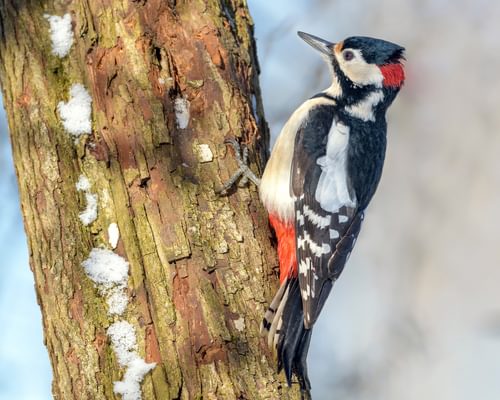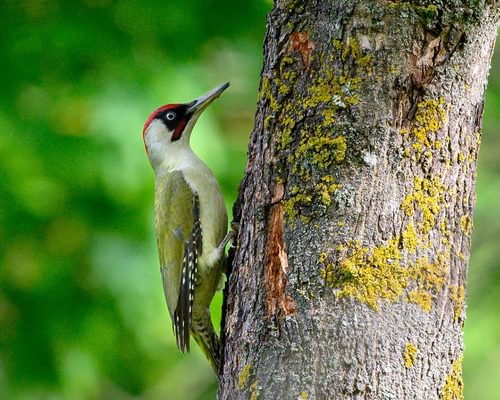Lesser Spotted Woodpecker
Dryobates minor
Visual Identification
Appearance
The Lesser Spotted Woodpecker is a diminutive bird, measuring just 14-16 cm in length. Its plumage is primarily black and white, with distinctive barred wings and a white-spotted back. The male sports a bright red crown patch, setting it apart from the female.
Juveniles resemble adults but have a duller overall appearance. The bird's small size and patterned plumage help it blend seamlessly with tree bark, making it challenging to spot despite its striking colouration.
The Lesser Spotted Woodpecker looks most similar to the Great Spotted Woodpecker, although that species is much larger and has red feathers under its tail.
Size
Length
14cm to 16cm
Wingspan
25cm to 27cm
Weight
17g to 25g
Habitat and Distribution
Habitats
Woodland
Garden
Wetland
Coastal
Urban
Farmland
Grassland
Desert
Tundra
Rainforest
Mountain
Savanna
Distribution
This species inhabits deciduous and mixed woodlands across Europe and parts of Asia. It prefers mature forests with a good supply of dead wood. In the UK, it's found primarily in England and Wales, favouring old oak and birch woodlands.
While generally non-migratory, some northern populations may move southward in harsh winters. The bird's range extends from Spain and the UK in the west to Japan in the east, with a patchy distribution in between.
February to April is the best time to find Lesser Spotted Woodpeckers in the United Kingdom as they are especially vocal and trees are not yet in leaf.
Elevation Range
Up to 2,000 meters
Climate zones
Temperate, Boreal
Distribution Map
This map gives you a rough idea of where you might spot a Lesser Spotted Woodpecker. The coloured areas show countries where these birds have been seen.
A few things to keep in mind:
- Birds might not be everywhere in the coloured areas, for example, they may be present around the coast of that country
- Where birds live can change with seasons and available food
- This map is quite simple - it doesn't show exact locations
We're working on making our maps even better! Soon, we hope to show you:
- More detailed maps for bigger countries, including state and region
- How birds move around during different seasons
Distribution by Region
Behaviour and Ecology
Bird Attributes
This feature is in beta. We'd love your feedback to improve it!
Share your thoughtsBird Attributes Explained
Our bird attributes system rates various aspects of a bird's capabilities on a scale of 0-100, based on data from field observations, scientific studies, and expert knowledge.
Attribute Categories:
- Agility: Manoeuvrability, speed, and grace in flight or movement.
- Strength: Physical power, often correlating with size and hunting abilities.
- Adaptability: Ability to thrive in various environments or changing conditions.
- Aggressiveness: Territorial behaviour and assertiveness, particularly during breeding seasons.
- Endurance: Stamina, often seen in migration patterns or foraging behaviours.
Understanding the Ratings:
- 0-20: Very Low
- 21-40: Low
- 41-60: Average
- 61-80: High
- 81-100: Very High
Remember, these attributes are relative to other bird species and don't necessarily indicate superiority.
Hover over the icon next to each attribute for more information.
Tap the icon next to each attribute for more information.
Agility
Reflects the bird's manoeuvrability, speed, and grace in flight or movement.
The Lesser Spotted Woodpecker displays remarkable agility, adeptly manoeuvring through trees and clinging vertically to trunks. Its undulating flight pattern and ability to navigate thin outer branches demonstrate exceptional aerial dexterity.
Strength
Indicates the bird's physical power, often correlating with size and hunting abilities.
Despite its small size, this woodpecker possesses sufficient strength to excavate nesting cavities in hard wood and drill rapidly when foraging. However, its diminutive stature limits its overall strength compared to larger species.
Adaptability
Represents the bird's ability to thrive in various environments or changing conditions.
The Lesser Spotted Woodpecker shows good adaptability, inhabiting various woodland types across a wide geographic range. Its ability to supplement its insect diet with seeds and berries in winter further demonstrates its adaptiveness.
Aggressiveness
Measures the bird's territorial behaviour and assertiveness, particularly during breeding seasons.
Generally solitary and non-confrontational, the Lesser Spotted Woodpecker isn't particularly aggressive. It primarily exhibits territorial behaviour during breeding season, but this is relatively mild compared to more aggressive bird species.
Endurance
Reflects the bird's stamina, often seen in migration patterns or foraging behaviours.
The bird's ability to drum up to 10-15 times per second and its continuous foraging activities suggest good endurance. Its capacity to survive in various climates, including harsh winters in some regions, also indicates respectable stamina.
Diet
The Lesser Spotted Woodpecker primarily feeds on insects, especially wood-boring beetle larvae, ants, and spiders. It uses its sharp, chisel-like beak to probe bark crevices and excavate small holes in search of prey. In winter, it may supplement its diet with seeds and berries.
Behaviour
This woodpecker exhibits a characteristic undulating flight pattern, alternating rapid wing beats with brief glides. It's often seen clinging vertically to tree trunks, using its stiff tail feathers for support while foraging.
Lesser Spotted Woodpeckers are generally solitary, only pairing up during the breeding season.
Vocalisation
The Lesser Spotted Woodpecker's call is a high-pitched 'kee-kee-kee' or 'pee-pee-pee', often repeated in quick succession.
Its drumming is rapid and brief, lasting about 1-1.5 seconds, and sounds like a soft, rolling 'brrrrrr'. This drumming is quieter but faster than that of larger woodpecker species.
Nesting & Breeding
Lesser Spotted Woodpeckers form monogamous pairs during the breeding season, which typically begins in April. Males attract females with drumming displays and calls. They excavate a new nesting cavity each year, usually in dead or decaying wood.
The female lays 4-6 glossy white eggs in the bare cavity. Both parents share incubation duties, which last about 11 days. Due to the shallow depth of the nesting holes, the eggs are particularly vulnerable to predation.
Chicks fledge after 18-21 days but may continue to be fed by their parents for several weeks afterward. By late summer, the young birds become independent and disperse to find their own territories.
Conservation and Status
Global Conservation Status
While listed as Least Concern globally, the Lesser Spotted Woodpecker has experienced significant declines in parts of its range, particularly in the UK. Habitat loss and fragmentation pose the main threats.
Conservation efforts focus on preserving mature deciduous woodlands and maintaining dead wood in forests.
Birdwatching Tips
- Listen for their distinctive drumming sound, which is faster but softer than larger woodpecker species.
- Look for movement high up in trees, especially on thin outer branches.
- Search for fresh holes in dead wood, a sign of recent foraging activity.
- In the UK, visit deciduous woodlands in early spring when trees are bare for better visibility.
Additional Information
Quick Facts
Predators
Main predators include sparrowhawks, cats, and martens. Eggs and nestlings are vulnerable to squirrels, woodpeckers, and some corvids.
Did You Know?
- The Lesser Spotted Woodpecker is the smallest woodpecker in Europe.
- It can drill up to 10-15 times per second when drumming.
- Despite its small size, it can excavate nesting cavities in hard wood.
Similar Birds
References
- 1 2
website: BirdLife International. 2018. Dryobates minor. The IUCN Red List of Threatened Species 2018: e.T22681076A130037386.
View source - 3
website, 2016: Tracewski et al.
Share Your Feedback
We value your opinion! Let us know what you think about this bird page.

